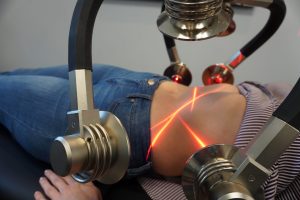 In 2003, the North American Association of Laser Therapy (NAALT) officially adopted the term “Phototherapy,” defining it as a therapeutic technique that employs photons (light energy) from the visible and infrared spectrum to promote tissue healing and alleviate pain. Recognized for its broad spectrum of benefits, Phototherapy influences cellular activity in several critical ways: it stimulates cell growth, boosts cell metabolism, enhances cell regeneration, and triggers an anti-inflammatory response. Additionally, it facilitates edema reduction, reduces the formation of fibrous tissue, stimulates nerve function, and decreases the production of substance P. The treatment also encourages the long-term production of nitric oxide and decreases the formation of bradykinin, histamine, and acetylcholine, while promoting the production of endorphins. These mechanisms are fundamental to the pain-relieving effects observed in patients treated with Phototherapy in our facility.
In 2003, the North American Association of Laser Therapy (NAALT) officially adopted the term “Phototherapy,” defining it as a therapeutic technique that employs photons (light energy) from the visible and infrared spectrum to promote tissue healing and alleviate pain. Recognized for its broad spectrum of benefits, Phototherapy influences cellular activity in several critical ways: it stimulates cell growth, boosts cell metabolism, enhances cell regeneration, and triggers an anti-inflammatory response. Additionally, it facilitates edema reduction, reduces the formation of fibrous tissue, stimulates nerve function, and decreases the production of substance P. The treatment also encourages the long-term production of nitric oxide and decreases the formation of bradykinin, histamine, and acetylcholine, while promoting the production of endorphins. These mechanisms are fundamental to the pain-relieving effects observed in patients treated with Phototherapy in our facility.
How It Works
Phototherapy works by delivering targeted light energy directly to the affected tissues, initiating a series of photo-biological reactions within the cells. This process starts with the absorption of light energy by photoreceptors within the cells, leading to the activation of cellular mitochondria. The energized mitochondria then increase the production of ATP (adenosine triphosphate), which is the energy currency of the cell. This boost in ATP production enhances cellular metabolism and promotes healing processes across various levels of tissue.
The anti-inflammatory effects are achieved through the modulation of signaling pathways that reduce the release of inflammatory mediators. Edema reduction occurs as the lymphatic system is stimulated, enhancing the removal of excess fluids. The stimulation of nerve function aids in relieving pain and improving sensory feedback. The decrease in the production of pain mediators like substance P, along with the increase in endorphins, contributes to significant pain relief and comfort for the patient.
By harnessing the power of light, Phototherapy offers a non-invasive, pain-free approach to healing and pain management, making it a valuable addition to modern therapeutic practices.
